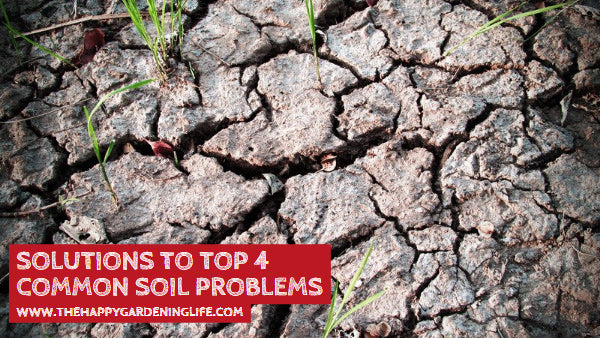
Solutions to Top 4 Common Soil Problems
Share
 Every gardener always wants to have good-quality soil for their garden. But sometimes soil problems are inevitable. There will be times when the ground will suddenly become too wet, dry, alkaline or acidic for your plants.
Every gardener always wants to have good-quality soil for their garden. But sometimes soil problems are inevitable. There will be times when the ground will suddenly become too wet, dry, alkaline or acidic for your plants.
These are the common soil issues that most gardeners have to go through. Don’t worry though because there are simple solutions to restoring your soil’s condition!
Remember that in order to obtain good soil, you need to monitor it well. No matter how poor quality a soil maybe, it can always be improved by adding in beneficial ingredients such as organic compost. Compost can do wonders for your vegetable garden and encourage your plants to grow much healthier.
Below is an article that will give you further details on how to address the most common soil issues. Be sure to read the tips and apply them to your garden for the best results.
Want to share this blog post online? Click the social buttons below!
Solutions to Top 4 Common Soil Problems
Problem No. 1: Soil is alkaline
Amendments to add: elemental sulfur, iron sulfate
When soil test results show high soil pH levels, your crops will benefit from some balance. Apply elemental sulfur and iron sulfate at rates dependent on your soil type—your soil-testing agency should provide recommendations. Elemental sulfur reacts slowly with the soil, so apply it the year before planting. The University of Minnesota recommends that additional iron sulfate applications of more than 7 pounds per 100 square foot be spaced one to two months apart. Amounts less than 7 pounds can be applied in a single application. It is safe to apply iron sulfate to plants.
Alkaline soils require continual buffering, so monitor your soil pH every one to two years and amend as needed. For perpetually alkaline soils, grow crops that tolerate high pH, including asparagus, beets, cabbage, lettuce, parsley and spinach.
Problem No. 2: Soil is acidic
Amendments to add: dolomitic lime, wood ash
For soils with low pH, lime is many farmers’ go-to amendment. Lime is best incorporated into the soil, but if you’re applying it to an already-established area, it can be watered in by rainfall or irrigation. The application rate for lime varies based on your soil’s pH and type. If using more than 25 pounds lime per 1,000 square feet, the University of Florida suggests allowing three to four weeks between applications to minimize negative impacts on plants, such as reduced availability of nutrients in the soil due to over application. Amounts less than 25 pounds can be applied in a single application. Wood ash should be applied at a rate of no more than 2 pounds per 100 square feet, according to the University of Minnesota, as excess wood ash will raise the potassium level in the soil, preventing plants from absorbing other nutrients.
In low-pH areas, you can still grow many acidic-soil-loving crops, including radishes, sweet potatoes, potatoes, blueberries, cranberries, raspberries and apples.
Problem No. 3: Soil is too dry
Amendments to add: compost
If your crop beds drain and dry out too quickly, they can benefit from the addition of compost, which will add both nutrients and water-retention capacity. The North Carolina State University Cooperative Extension recommends incorporating a 3- to 6-inch layer of decomposed organic material on the ground that needs amended. Be sure to use mature compost, as compost that hasn’t fully decomposed can actually deprive your growing plants of nutrients as it continues to break down.
In addition to incorporating compost into the soil, mulch crop areas to reduce water evaporation from the soil, then turn the mulch into the soil at the end of the growing season.
Problem No.4: Soil is too wet
Amendments to add: compost, sand, 78M pea gravel
Soggy, compacted ground needs an amendment to add space between soil particles and allow better drainage. An effective way to combat this is to incorporate gravel or sand into the soil—not simply adding it as a drainage layer below the topsoil. The addition of these amendments will also require you to add organic materials to boost nutrients. Avoid adding sand to clay soils, as the mixture can set up like concrete. According to the University of Georgia Cooperative Extension, clay soils should generally be amended with 1 cubic yard of amendment (such as gravel or compost) per 100 square feet. The amendment rate for non-clay soils will vary depending on soil type and the amendment you choose to use.
In addition to using amendments, build raised beds to encourage crop areas to drain faster. Plant crops in areas away from natural water pathways. Do not work soil, particularly dense clay soil, when it’s wet, as this will only add to your soil-compaction problems.
Article Source: hobbyfarms.com
